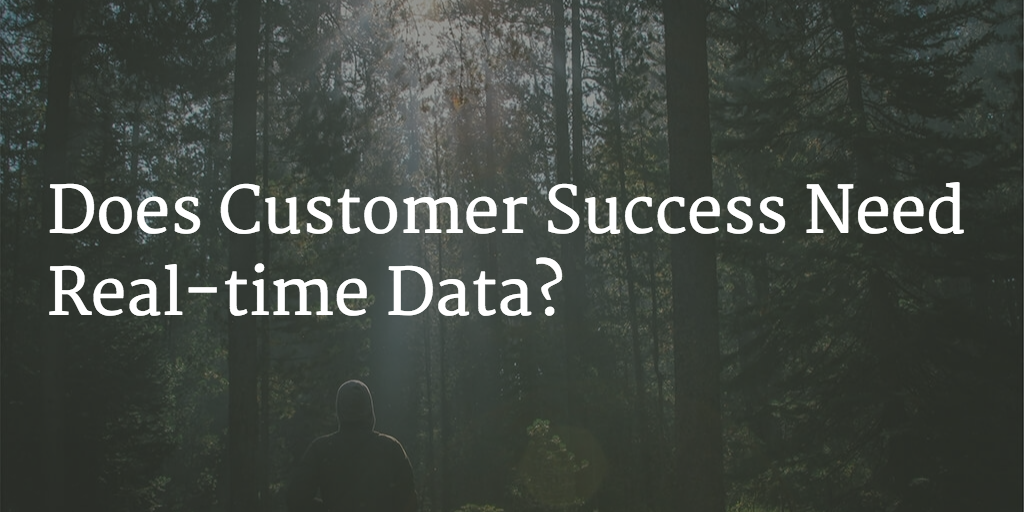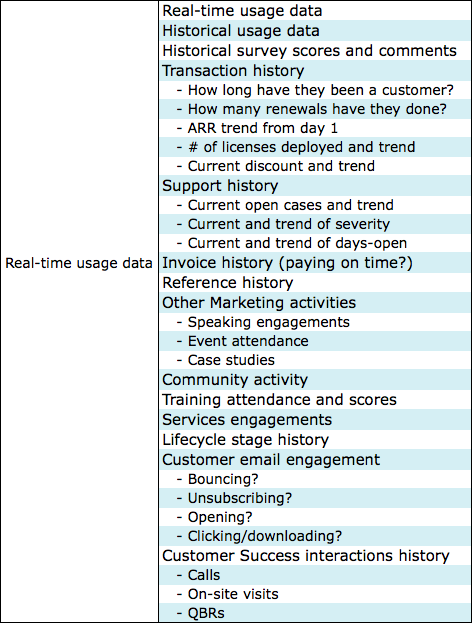So, does Customer Success Need Real-time Data? The answer to that question is an emphatic “no”.
This debate reminds me of one of my favorite sayings – “If your only tool is a hammer, every problem looks like a nail”. Customer Success requires information to be successful. Sometimes we use the word “data” interchangeably with “information”. They are clearly not the same but let’s not debate that right now. Customer Success relies on data/information to effectively manage customers. No one argues that.
Usage data, delivered at the appropriate pace for your business, is but ONE important part of the necessary data set.
Limited Real Time Data Can’t Drive Customer Success
If the only source of data that can be captured is usage data, and the only method for capturing it is through a real-time feed, then the solution to every problem becomes real-time usage data. If that was my only tool, I’m sure I’d use it for every problem, too. But, given choices, I’d like more information than just that and I don’t need that information in real-time except in rare cases.
Let’s explore the real-time aspect of this scenario. What does it mean to get real-time data? Simply put, it means you get the data immediately when it happens. In the specific case we are discussing here, it means you get notified of the action a user takes with your product, the second it happens. Sounds pretty cool, huh? Out of context, most of us would nod our heads at that idea. Data is good. More data is better. More data more frequently is even better, right?
Not so fast my friends.
A Customer Success Manager’s Perspective
Let’s think this through from the perspective of a Customer Success Manager. And let’s make it really simple for starters. Let’s say I’m a CSM and I have exactly one customer. That customer is obviously really important to me. But, what happens if I start getting real-time usage data for that customer? I’m sitting at my desk using my Customer Success Management application and I get notified (or I notice) that a user at my customer just logged in. That’s possibly interesting, but certainly not actionable.
Now let’s say another user logs in. And then the first one logs out and then logs back in. Now the second user clicks the “Submit Report” button. And now the first user clicks on the “Analytics” tab. Wow, things are really happening here. Or are they? If this is my world – getting real-time usage data – what am I to do with it? My job is to make sure my customer is getting value out of my product (and ultimately renews their contract). Most likely a customer can’t get value out of your product without logging in.
But what am I to make of three logins by two users over the course of an hour or so? Am I going to act on that information because I got it in real-time? Almost certainly not. Is it any more valuable in real-time than if I got it once an hour? Or once a day? Or once a week? I’d argue that getting it in real-time is not only not necessary, it’s a hindrance because it creates too much noise.
Real Time Usage Data Alone Lacks Context
The way to determine if your customer is effectively using your product requires way more than just real-time data. It requires context and it requires trending. And I don’t mean minute-to-minute trending (users do things other than use our products every day). And I don’t mean day-to-day trending (users have all-day meetings, too). One could argue that even week-to-week trending creates too much noise (users take vacations, too). Ask yourself this question – if you had to choose which you wanted to most effectively monitor your customer, would you choose 18 months of monthly historical usage data or would you choose 18 hours or 18 days of real-time usage data? If the answer isn’t already clear, then keep reading.
Now let’s get realistic. Most CSMs have dozens, if not hundreds, of customers. So take our previous example and multiply by 100. Isn’t it obvious that real-time usage data is not really going to be helpful to them because it’s just way too much? They are much more likely to want to know what their customer’s trends are month over month for the past few months rather than what happened the last hour, today, or even yesterday. In the end, what happens to real-time data eventually, is that it gets rolled up to weekly or monthly data and those trends are the ones that are watched. So, if real-time is valuable only when it gets rolled up to weekly and monthly, then the real-time aspect of it is actually a nuisance, not a help. I’d much rather start with data that is already aggregated at the level I find useful.
There are exceptions to this rule but most are very remote edge cases. There is one that’s a bit more mainstream and worth mentioning though. If you are monitoring the usage of a free trial customer to determine when a Sales Rep should reach out to try to convert them into a paying customer, then daily data does matter, in part because it’s the only thing you have to go on. There is no history and there is typically no other data available on that prospect. And it’s in this world that many of the Customer Success application vendors grew up which explains why it is their go-to strategy. In this particular use case, it’s very valuable. In the holistic world of Customer Success, not so much.
Is Usage Data the Holy Grail?
OK, so let’s now talk about whether usage data is the Holy Grail. And for those of you who have been reading along for the past two years, this is déjà vu all over again because I’ve talked about it before. Here and here are a couple of examples. Forgive me for reiterating but I’ll do it briefly and try to choose some different words.
At its very core, Customer Success is about monitoring and improving customer health. Growth of your install base, the bottom line measure of any Customer Success team, is driven by customer health. Yes, there are exceptions. Customers churn because they are acquired or go out of business. But if we consider only the set of customer situations which are in your control, customer health is what drives the renewal, up-sell, down-sell, and churn. Defining customer health is a tricky process, but one well worth doing. Here’s some help in that endeavor should you choose to go there.
Customer Success: Monitoring and Improving Customer Health
As a Customer Success organization, I guarantee you that you will go down this path sometime soon. It’s not a matter of if, but when. And, if you do it well, you will find that the customer’s health score will directly correlate to churn, upsell, downsell and renewals. It can, in other words, become the best predictor of the growth of your install base. Given that, I pose to you this question. If you had a group of customers whose growth you were responsible for, which of the two sets of data below would you choose to help you manage those customers and determine their overall health?
I could go on and on. And so could you. If you thought about it for a few minutes, you’d easily come up with 10 more things that are indicators of customer health. Executive relationship with the customer, self-sufficiency of the customer, app reviews, social media commentary, etc. The bottom line is this – if you are going to take the time, energy, and money to solve this problem, at least plan to solve the whole problem. Shortcuts never pay off. Don’t settle for just usage data and don’t buy into the idea that you need real-time usage data. You most certainly don’t. And even if you do decide you need it for one of those edge cases, don’t stop there. Go ahead and get that piece of data but add to it so you can get a complete picture of customer health. In order to survive as a recurring revenue business, you will ultimately have to solve the WHOLE problem.
I’d suggest you start your process with that in mind. No need to boil the ocean from day one, but definitely think about the size of the overall challenge and plan accordingly.


